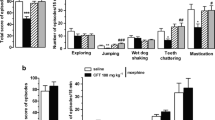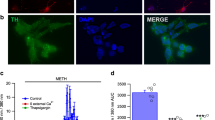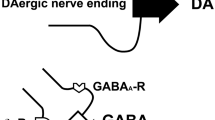Abstract
Uridine, a pyrimidine nucleoside, has been proposed to be a potential signaling molecule in the central nervous system. The understanding of uridine release in the brain is therefore of fundamental importance. The present study was performed to determine the characteristics of basal and morphine-induced uridine release in the striatum of freely moving mice by using the microdialysis technique. To ascertain whether extracellular uridine was derived from neuronal release, the following criteria were applied: sensitivity to (a) K+ depolarization, (b) Na+ channel blockade and (c) removal of extracellular Ca2+. Uridine levels were not greatly affected by infusion of tetrodotoxin (TTX) and were unaffected by either Ca2+-free medium or in the presence of EGTA (a calcium chelator), suggesting that basal extracellular uridine levels were maintained mainly by non-vesicular release mechanisms. In addition, both systemic and local application of morphine increased striatal uridine release. The morphine-induced release was reversed by naloxone pretreatment, but was unaffected by TTX or EGTA infusion. Moreover, co-administration of morphine and nitrobenzylthioinosine (NBTI, an inhibitor of nucleotide transporter) produced increases of uridine levels similar to that produced by NBTI or morphine alone, suggesting a nucleotide transporter mechanism involved. Taken together, these findings suggest that morphine produces a μ-opioid receptor-mediated uridine release via nucleoside transporters in a TTX- and calcium-independent manner.





Similar content being viewed by others
References
Yamamoto T, Koyama H, Kurajoh M, Shoji T, Tsutsumi Z, Moriwaki Y (2011) Biochemistry of uridine in plasma. Clin Chim Acta 412:1712–1724
Dobolyi A, Juhasz G, Kovacs Z, Kardos J (2011) Uridine function in the central nervous system. Curr Top Med Chem 11:1058–1067
Kimura T, Ho IK, Yamamoto I (2001) Uridine receptor: discovery and its involvement in sleep mechanism. Sleep 24:251–260
Kimura-Takeuchi M, Inoue S (1993) Lateral preoptic lesions void slow-wave sleep enhanced by uridine but not by muramyl dipeptide in rats. Neurosci Lett 157:17–20
Kimura-Takeuchi M, Inoue S (1993) Differential sleep modulation by sequentially administered muramyl dipeptide and uridine. Brain Res Bull 31:33–37
Zhao Q, Marolewski A, Rusche JR, Holmes GL (2006) Effects of uridine in models of epileptogenesis and seizures. Epilepsy Res 70:73–82
Roberts CA, Kreisman NR, Waltman M (1974) Uridine anticonvulsant effects: selective control of nucleoside incorporation in experimental epilepsy. Epilepsia 15:479–500
Peters GJ, Van Groeningen CJ, Laurensse EJ, Lankelma J, Leyva A, Pinedo HM (1987) Uridine-induced hypothermia in mice and rats in relation to plasma and tissue levels of uridine and its metabolites. Cancer Chemother Pharmacol 20:101–108
Peters GJ, Van Groeningen CJ, Laurensse E, Kraal I, Leyva A, Lankelma J, Pinedo HM (1987) Effect of pyrimidine nucleosides on body temperatures of man and rabbit in relation to pharmacokinetic data. Pharm Res 4:113–119
Holguin S, Martinez J, Chow C, Wurtman R (2008) Dietary uridine enhances the improvement in learning and memory produced by administering DHA to gerbils. FASEB J 22:3938–3946
Dobolyi A, Szikra T, Kekesi AK, Kovacs Z, Juhasz G (1999) Uridine is released by depolarization and inhibits unit activity in the rat hippocampus. Neuroreport 10:3049–3053
Kardos J, Kovacs I, Szarics E, Kovacs R, Skuban N, Nyitrai G, Dobolyi A, Juhasz G (1999) Uridine activates fast transmembrane Ca2+ ion fluxes in rat brain homogenates. Neuroreport 10:1577–1582
Dobolyi A, Reichart A, Szikra T, Nyitrai G, Kekesi KA, Juhasz G (2000) Sustained depolarisation induces changes in the extracellular concentrations of purine and pyrimidine nucleosides in the rat thalamus. Neurochem Int 37:71–79
Slezia A, Kekesi AK, Szikra T, Papp AM, Nagy K, Szente M, Magloczky Z, Freund TF, Juhasz G (2004) Uridine release during aminopyridine-induced epilepsy. Neurobiol Dis 16:490–499
Guarneri P, Guarneri R, La Bella V, Piccoli F (1985) Interaction between uridine and GABA-mediated inhibitory transmission: studies in vivo and in vitro. Epilepsia 26:666–671
Myers CS, Napolitano M, Fisher H, Wagner GC (1993) Uridine and stimulant-induced motor activity. Proc Soc Exp Biol Med 204:49–53
Myers CS, Fisher H, Wagner GC (1995) Uridine reduces rotation induced by L-dopa and methamphetamine in 6-OHDA-treated rats. Pharmacol Biochem Behav 52:749–753
Kulkarni A, Mcvaugh W, Lawrence B, Pizzini R, Wolinsky I, Vanburen C, Rudolph F, Dafny N (1997) Nutritional supplementation of nucleotides restores opioid CNS-mediated phenomena in mice. Life Sci 61:1691–1696
Wang TL, Wu CF, Yang JY, Wang F, Song W (2009) Effect of morphine on brain uracil release in mouse striatum detected by microdialysis. Neurosci Lett 457:89–92
Sun JY, Yang JY, Wang F, Wang JY, Song W, Su GY, Dong YX, Wu CF (2011) Lesions of nucleus accumbens affect morphine-induced release of ascorbic acid and GABA but not of glutamate in rats. Addict Biol 16:540–550
Van Der Zeyden M, Oldenziel WH, Rea K, Cremers TI, Westerink BH (2008) Microdialysis of GABA and glutamate: analysis, interpretation and comparison with microsensors. Pharmacol Biochem Behav 90:135–147
Westerink BH, Tuntler J, Damsma G, Rollema H, De Vries JB (1987) The use of tetrodotoxin for the characterization of drug-enhanced dopamine release in conscious rats studied by brain dialysis. Naunyn Schmiedebergs Arch Pharmacol 336:502–507
Drew KL, O’connor WT, Kehr J, Ungerstedt U (1989) Characterization of gamma-aminobutyric acid and dopamine overflow following acute implantation of a microdialysis probe. Life Sci 45:1307–1317
Yamashita T (2012) Ca2+-dependent regulation of synaptic vesicle endocytosis. Neurosci Res 73:1–7
Sarne Y, Fields A, Keren O, Gafni M (1996) Stimulatory effects of opioids on transmitter release and possible cellular mechanisms: overview and original results. Neurochem Res 21:1353–1361
Yawata A, Matsuhashi Y, Kato H, Uemura K, Kusano G, Ito J, Chikuma T, Hojo H (2009) Inhibition of nucleoside transport and synergistic potentiation of methotrexate cytotoxicity by cimicifugoside, a triterpenoid from Cimicifuga simplex. Eur J Pharm Sci 38:355–361
Anderson CM, Xiong W, Geiger JD, Young JD, Cass CE, Baldwin SA, Parkinson FE (1999) Distribution of equilibrative, nitrobenzylthioinosine-sensitive nucleoside transporters (ENT1) in brain. J Neurochem 73:867–873
Anderson CM, Baldwin SA, Young JD, Cass CE, Parkinson FE (1999) Distribution of mRNA encoding a nitrobenzylthioinosine-insensitive nucleoside transporter (ENT2) in rat brain. Brain Res Mol Brain Res 70:293–297
Gray JH, Owen RP, Giacomini KM (2004) The concentrative nucleoside transporter family, SLC28. Pflugers Arch 447:728–734
King AE, Ackley MA, Cass CE, Young JD, Baldwin SA (2006) Nucleoside transporters: from scavengers to novel therapeutic targets. Trends Pharmacol Sci 27:416–425
Narita M, Mizoguchi H, Nagase H, Suzuki T, Tseng LF (2001) Involvement of spinal protein kinase Cgamma in the attenuation of opioid mu-receptor-mediated G-protein activation after chronic intrathecal administration of [D-Ala2, N-MePhe4, Gly-Ol5]enkephalin. J Neurosci 21:3715–3720
Lu G, Zhou QX, Kang S, Li QL, Zhao LC, Chen JD, Sun JF, Cao J, Wang YJ, Chen J, Chen XY, Zhong DF, Chi ZQ, Xu L, Liu JG (2010) Chronic morphine treatment impaired hippocampal long-term potentiation and spatial memory via accumulation of extracellular adenosine acting on adenosine A1 receptors. J Neurosci 30:5058–5070
Sawynok J, Liu XJ (2003) Adenosine in the spinal cord and periphery: release and regulation of pain. Prog Neurobiol 69:313–340
Coe I, Zhang Y, Mckenzie T, Naydenova Z (2002) PKC regulation of the human equilibrative nucleoside transporter, hENT1. FEBS Lett 517:201–205
Iliodromitis EK, Miki T, Liu GS, Downey JM, Cohen MV, Kremastinos DT (1998) The PKC activator PMA preconditions rabbit heart in the presence of adenosine receptor blockade: is 5′-nucleotidase important? J Mol Cell Cardiol 30:2201–2211
Kiss A, Farah K, Kim J, Garriock RJ, Drysdale TA, Hammond JR (2000) Molecular cloning and functional characterization of inhibitor-sensitive (mENT1) and inhibitor-resistant (mENT2) equilibrative nucleoside transporters from mouse brain. Biochem J 352(Pt 2):363–372
Harlan RE, Kailas SR, Tagoe CE, Garcia MM (2004) Morphine actions in the rat forebrain: role of protein kinase C. Brain Res Bull 62:285–295
Ping X, Ma Y, Li Y, Qi C, Sun X, Lv X, Cui C (2012) Essential role of protein kinase C in morphine-induced rewarding memory. Neuropharmacology 62:959–966
Agnati LF, Fuxe K, Ruggeri M, Merlo Pich E, Benfenati F, Volterra V, Ungerstedt U, Zini I (1989) Effects of chronic treatment with uridine on striatal dopamine release and dopamine related behaviours in the absence or the presence of chronic treatment with haloperidol. Neurochem Int 15:107–113
Acknowledgments
This research is partly supported by the Project of Key Laboratory for New Drug Screening, Key Laboratory for Pharmacodynamics, of Liaoning Province, and by the National Key Scientific Project for New Drug Discovery and Development, (2010ZX09401-304), 2010-2012, P. R. China.
Author information
Authors and Affiliations
Corresponding author
Rights and permissions
About this article
Cite this article
Song, W., Wu, CF., Liu, P. et al. Characterization of Basal and Morphine-Induced Uridine Release in the Striatum: An In Vivo Microdialysis Study in Mice. Neurochem Res 38, 153–161 (2013). https://doi.org/10.1007/s11064-012-0903-1
Received:
Revised:
Accepted:
Published:
Issue Date:
DOI: https://doi.org/10.1007/s11064-012-0903-1




